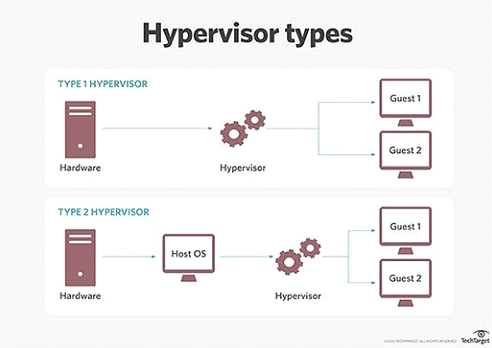Introduction
A bare-metal hypervisor, also known as a Type 1 hypervisor, is a virtualization software that is installed directly onto the computing hardware. This type of hypervisor controls not only the hardware, but one or more guest operating systems (OSes). In comparison, a hosted hypervisor, or Type 2 hypervisor, runs within the host OS, so the underlying hardware is managed by the host OS.

Bare-metal hypervisors feature high availability and resource management; they also provide better performance, scalability and stability because of their direct access to the hardware. On the other hand, the built-in device drivers can limit hardware support. Examples of popular bare-metal hypervisors are Microsoft Hyper-V, Citrix XenServer and VMware ESXi.
Key differences
A bare-metal or Type 1 hypervisor is significantly different from a hosted or Type 2 hypervisor. Although both are capable of hosting virtual machines
(VMs), a hosted hypervisor runs on top of a parent OS, whereas a bare-metal hypervisor is installed directly onto the server hardware. This difference in the way that the hypervisors are installed leads to several other key differences.
One of the biggest differences between a bare-metal hypervisor and a hosted hypervisor lies in the way that VMs consume hardware resources.
Because a bare-metal hypervisor is installed directly on the server hardware, a VM can access the hardware directly. Conversely, a VM that is running on a hosted hypervisor must pass hardware requests through the parent OS. This means that a bare-metal hypervisor generally offers far better VM performance than a hosted hypervisor.
Similarly, a bare-metal hypervisor offers better security than a hosted hypervisor. Because a hosted hypervisor is dependent on an underlying OS, security vulnerabilities within that OS could potentially be used to penetrate VMs and the guest OSes running on them.

Bare-metal hypervisor use cases
Bare-metal hypervisors are best suited for organizations that require high performance, management capabilities, scalability, and strong security.
As previously noted, a bare-metal hypervisor is installed directly on the server hardware. This means that VMs run at the hardware’s native speed, as opposed to having their performance affected by an OS that is running on the host.
Scalability
Bare-metal hypervisors also tend to be more scalable than hosted hypervisors. Hosted hypervisors’ scalability is limited by the underlying OS. If the OS does not support clustering or if it only supports a relatively small amount of memory, then a hypervisor running on top of the OS will also be subject to those limitations. Because bare-metal hypervisors are not installed on top of a host OS, they tend to be highly scalable.
Practicality
The bare-metal hypervisor vendors also generally offer a management console that is designed to support large-scale hypervisor deployments. Some examples are VMware vCenter Server or Microsoft System Center Virtual Machine Manager. These consoles make it practical to manage large-scale deployments.
Finally, because a bare-metal hypervisor is not running on top of an underlying OS, it tends to be far more secure than a hosted hypervisor.
Bare-metal virtualization is ideally suited to large organizations or to those organizations with significant performance or security requirements. Hosted hypervisors tend to be a better fit for lab environments or for use in SMB environments.
Benefits of bare-metal hypervisors
Performance |
VMs can run at native hardware speeds. |
Security |
VMs aren't affected by vulnerabilities that might exist in an underlying OS, as would be the case for a hosted hypervisor. |
Scalability |
Enterprise grade bare-metal hypervisors support the creation of large failover clusters, and can generally take advantage of all a server's hardware resources -- memory, CPU, etc. |
Manageability |
Bare-metal hypervisor vendors offer management consoles that enable virtualization hosts to be collectively managed through a single console. |
Drawbacks of bare-metal hypervisors
Cost |
Bare-metal hypervisors tend to be significantly more expensive than hosted hypervisors. They also require dedicated hardware. |
Complexity |
Enterprise class bare-metal hypervisors can be quite complex and there might be a substantial learning curve associated with their use. |
SCHEDULE MY CUSTOM CONSULTATION
You Just contact us now to get Bare Metal Hypervisor tool and our experts guide you how to work with bare metal hypervisor.


